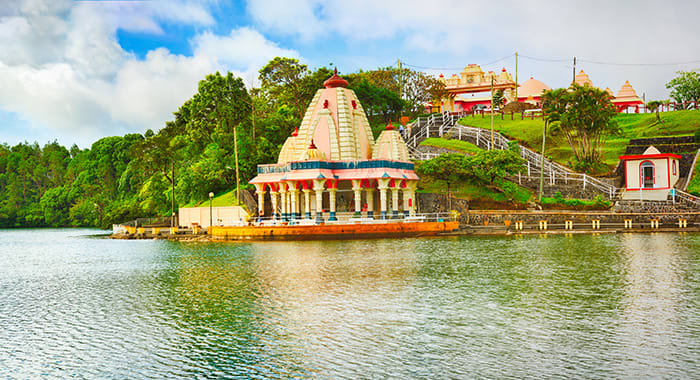Mauritius is a beach-lover’s paradise, no doubt. A haven of white sands, blue lagoons and clear waters. However, there’s much more to the island than its beautiful coastline. From natural wonders to a Hindu pilgrimage site, it will surprise and awe at every turn.
Île aux Cerfs
This privately-owned island sits off the east coast of Mauritius. Île aux Cerfs, known in English as ‘deer island’, was once inhabited by deer. What it features today is 4km of white sands, encircled by turquoise waters and a vast lagoon – the biggest in Mauritius. A paradise for snorkellers, with a coral reef rich in marine life.
Black River Gorges National Park
With over 50km of trails, this is the largest protected forest in Mauritius. Hiking here involves beautiful waterfalls, a dramatic gorge and breathtaking views. All between a series of towering mountains. The park protects endemic animals and birds like the Mauritian flying fox, the pink pigeon and the Mauritius cuckoo-shrike.
Flic-en-Flac
A small town with a funky name, thought to come from an Old Dutch phrase meaning free and flat land. We’re jealous of those 18th-century explorers, for whom pristine beaches didn’t cost a penny. However, they didn’t have the luxury hotels, water sports and restaurants that make it even more appealing today.
Sir Seewoosagur Ramgoolam Botanical Garden
First formed in 1770, this is the oldest botanical garden in the Southern Hemisphere. It takes its current name from the first prime Minster of Mauritius and is best known for its long pond filled with giant water lilies. The garden houses 85 types of palms as well as sugar canes, spices and ebonies. Within easy reach of most places on the island.
Seven Coloured Earths
In the Charamel plain in south-western Mauritius, these sand dunes get their vibrant colours from the conversion of basaltic lava to clay minerals. The seven main colours are red, violet, blue, purple, green, yellow and brown. Sunrise is the best time to see this phenomenon.
Le Morne Brabant
Peninsula on the south-western tip of the island. A UNESCO World Heritage Site, it served as a refuge for runaway slaves in the early 19th-century, who used the summit as a look-out to prevent their re-capture. Hike to the top of the summit and you are rewarded with panoramic views of the lagoons and island.
Ganga Talao
Ganga Talao is a crater lake about 550 metres above sea level, and one of the most sacred places for Hindus to visit. It originates from 1972 when a priest from India poured water from the Ganges into the lake. Hence the name – Ganga for Ganges and Talao meaning pool. At the lake, there are many statues of the Hindu gods.
Trou-aux-Biches
A favourite with honeymooners. With top-end resorts and stylish boutiques, plus one of the best beaches on the island, it’s not hard to see why. Apart from basking in the bliss, there’s much for you to enjoy – from water sports and snorkelling to spas and a nearby golf course.
Chamarel Waterfall
In the same area as the Seven Coloured Earths, these waterfalls are the highest in Mauritius, falling 95 metres amidst a backdrop of forests and mountains. You can watch them from an upper deck or enjoy a swim in the fresh shallow waters. There’s also a chance you might spot some wild monkeys.
Blue Penny Museum
In Port Louis, the capital Mauritius, Blue Penny is dedicated to the art and history of the island. It’s prize possessions are the two issues of the Post Office stamp from 1847, although there’s also a collection of old maps, documents, sculptures and paintings.

.jpg)

.jpg)

.jpg)

.jpg)



.jpg)



.jpg)

.jpg)

.jpg)

